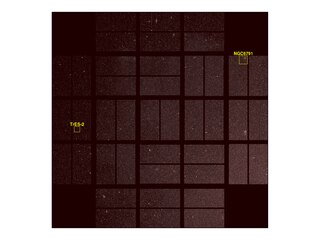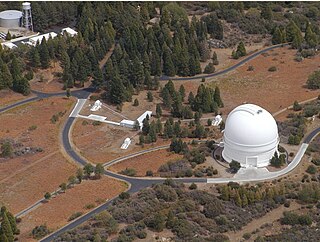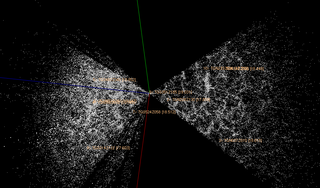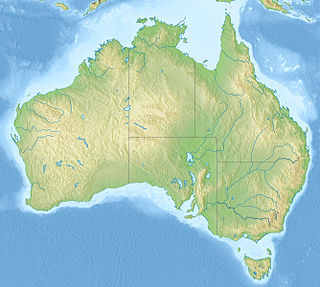
In astronomy, first light is the first use of a telescope to take an astronomical image after it has been constructed. This is often not the first viewing using the telescope; optical tests will probably have been performed in daylight to adjust the components.

The Infrared Astronomical Satellite (IRAS) was the first-ever space telescope to perform a survey of the entire night sky at infrared wavelengths.

Palomar Observatory is an astronomical research observatory in San Diego County, California, United States, in the Palomar Mountain Range. It is owned and operated by the California Institute of Technology (Caltech). Research time at the observatory is granted to Caltech and its research partners, which include the Jet Propulsion Laboratory (JPL), Yale University, and the National Optical Observatories of China.
Near-Earth Asteroid Tracking (NEAT) was a program run by NASA and the Jet Propulsion Laboratory, surveying the sky for near-Earth objects. NEAT was conducted from December 1995 until April 2007, at GEODSS on Hawaii, as well as at Palomar Observatory in California. With the discovery of more than 40 thousand minor planets, NEAT has been one of the most successful programs in this field, comparable to the Catalina Sky Survey, LONEOS and Mount Lemmon Survey.
Catalina Sky Survey is an astronomical survey to discover comets and asteroids. It is conducted at the Steward Observatory's Catalina Station, located near Tucson, Arizona, in the United States.
The Digitized Sky Survey (DSS) is a digitized version of several photographic astronomical surveys of the night sky, produced by the Space Telescope Science Institute between 1983 and 2006.

In astronomy, a redshift survey is a survey of a section of the sky to measure the redshift of astronomical objects: usually galaxies, but sometimes other objects such as galaxy clusters or quasars. Using Hubble's law, the redshift can be used to estimate the distance of an object from Earth. By combining redshift with angular position data, a redshift survey maps the 3D distribution of matter within a field of the sky. These observations are used to measure detailed statistical properties of the large-scale structure of the universe. In conjunction with observations of early structure in the cosmic microwave background, these results can place strong constraints on cosmological parameters such as the average matter density and the Hubble constant.

The UK Schmidt Telescope (UKST) is a 1.24 metre Schmidt telescope operated by the Australian Astronomical Observatory ; it is located adjacent to the 3.9 metre Anglo-Australian Telescope at Siding Spring Observatory, Australia. It is very similar to the Samuel Oschin telescope in California. The telescope can detect objects down to magnitude 21 after an hour of exposure on photographic plates.

An astronomical survey is a general map or image of a region of the sky that lacks a specific observational target. Alternatively, an astronomical survey may comprise a set of many images or spectra of objects that share a common type or feature. Surveys are often restricted to one band of the electromagnetic spectrum due to instrumental limitations, although multiwavelength surveys can be made by using multiple detectors, each sensitive to a different bandwidth.
The DEEP2 Survey or DEEP2 was a two-phased Redshift survey of the Redshift z=~1 universe. It used the twin 10 metre Keck telescopes in Hawaii to measure the spectra and hence the redshifts of approximately 50,000 galaxies. It was the first project to study galaxies in the distant Universe with the resolution of local surveys like the Sloan Digital Sky Survey and was completed in 2013.

SkyMapper is a fully automated 1.35 m (4.4 ft) wide-angle optical telescope at Siding Spring Observatory in northern New South Wales, Australia. It is one of the telescopes of the Research School of Astronomy and Astrophysics of the Australian National University (ANU). The telescope has a compact modified Cassegrain design with a large 0.69 m secondary mirror, which gives it a very wide field of view: its single, dedicated instrument, a 268-million pixel imaging camera, can photograph 5.7 square degrees of sky. The camera has six light filters which span from ultraviolet to near infrared wavelengths.
Sky-Map.org is a wiki and interactive sky map that covers more than half a billion celestial objects. Users can view the whole star sky at once and zoom in to view areas in greater detail. WikiSky includes many stars, galaxies, constellations, and planets, but it is still in development. Users can also edit information about different stars by writing articles, adding Internet links, uploading images, or create a special interest group for a specific task. The website, although still available for users to visit, has not shown much activity since 2010.
The Anglo Australian Planet Search or (AAPS) is a long-term astronomical survey started in 1998 and continuing to the present. It is being carried out on the 3.9-metre Anglo-Australian Telescope (AAT) of the Anglo-Australian Observatory in Australia. The purpose of this survey is to catalog planets around more than 240 nearby stars of the southern hemisphere. For its observations, the AAT uses the University College London Echelle Spectrograph, UCLES, an echelle spectrograph from the University College London located at the telescope's coudé focus. This survey uses the radial velocity method to search for extrasolar planets.
The Supernova Legacy Survey Program is a project designed to investigate dark energy, by detecting and monitoring approximately 2000 high-redshift supernovae between 2003 and 2008, using MegaPrime, a large CCD mosaic at the Canada-France-Hawaii Telescope. It also carries out detailed spectroscopy of a subsample of distant supernovae.
A transient astronomical event, often shortened by astronomers to a transient, is an astronomical object or phenomenon whose duration may be from milliseconds to days, weeks, or even several years. This is in contrast to the timescale of the millions or billions of years during which the galaxies and their component stars in our universe have evolved. Singularly, the term is used for violent deep-sky events, such as supernovae, novae, dwarf nova outbursts, gamma-ray bursts, and tidal disruption events, as well as gravitational microlensing, transits, eclipses, and comets. These events are part of the broader topic of time domain astronomy.

Arp 271 is a pair of similarly sized interacting spiral galaxies, NGC 5426 and NGC 5427, in the constellation of Virgo. It is not certain whether the galaxies are going to eventually collide or not. They will continue interacting for tens of millions of years, creating new stars as a result of the mutual gravitational attraction between the galaxies, a pull seen in the bridge of stars already connecting the two. Located about 130 million light-years away, the Arp 271 pair is about 130,000 light-years across. It was originally discovered in 1785 by William Herschel. It is speculated, that the Milky Way will undergo a similar collision in about five billion years with the neighbouring Andromeda Galaxy, which is currently located about 2.6 million light-years away.
The Deep Near Infrared Survey of the Southern Sky (DENIS) was a deep astronomical survey of the southern sky in the near-infrared and optical wavelengths, using an ESO 1-meter telescope at the La Silla Observatory. It operated from 1996 to 2001.

The Visible Multi-Object Spectrograph (VIMOS) is a wide field imager and a multi-object spectrograph installed at the European Southern Observatory's Very Large Telescope (VLT), in Chile. The instrument used for deep astronomical surveys delivers visible images and spectra of up to 1,000 galaxies at a time. VIMOS images four rectangular areas of the sky, 7 by 8 arcminutes each, with gaps of 2 arcminutes between them. Its principal investigator was Olivier Le Fèvre.
The All Sky Automated Survey for SuperNovae (ASAS-SN) is an automated program to search for new supernovae and other astronomical transients, headed by astronomers from the Ohio State University, including Christopher Kochanek and Krzysztof Stanek. It has 20 robotic telescopes in both the northern and southern hemispheres. It can survey the entire sky approximately once every day.

The Hyperion proto-supercluster is the largest and earliest known proto-supercluster, 5,000 times the mass of the Milky Way and seen at 20% of the current age of the universe. It was discovered in 2018 by analysing the redshifts of 10,000 objects observed with the Very Large Telescope in Chile.









